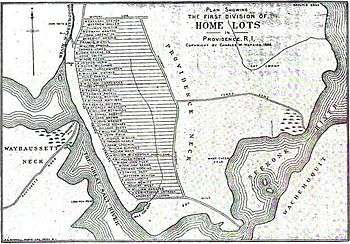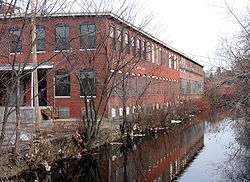History of Providence, Rhode Island

The Rhode Island city of Providence has a nearly four hundred-year history integral to that of the United States, including significance in the Transatlantic Slave Trade and the American Revolutionary War with the provision of leadership and fighting strength, the quartering of troops, and the supplement of goods to residents by circumventing the blockade of Newport. The city is also noted for one of the first bloodsheds of the American Revolution in the Gaspée Affair. Additionally, Providence is notable for economic shifts from trading to manufacturing, the decline of which contemporaneous to the Great Depression devastated the city, and eventual economic recovery through investment of public funds.
Founding and colonial era
| Part of a series on |
| Baptists |
|---|
 |
|
Background |
|
|


The area which is now Providence was first settled in June 1636 by prominent Baptist Roger Williams and other religious exiles. It was one of the original Thirteen Colonies of the United States.[1] Williams had been exiled from the Massachusetts Bay Colony for his outspoken beliefs concerning distinction of state government and religion:
| “ | All civil states, with their officers of justice, in their respective constitutions and administrations, are proved essentially civil, and therefore not judges, governors, or defenders of the spiritual, or Christian, state and worship | ” |
- — Roger Williams[2]
Williams secured a title from the Narragansett natives around this time and gave the city its present name. Williams also cultivated Providence Plantations as a refuge for persecuted religious dissenters, especially but not exclusively Baptists, as he himself had been exiled from Massachusetts.[3] Baptist minister Chad Brown was a leading 17th century land owner in Providence and ancestor to the prominent Brown family and Nicholas Brown, Jr. for whom Brown University was later named. Providence Plantations was an agricultural and fishing community, though its lands were difficult to farm, and its borders were disputed with Connecticut and Massachusetts.[3] During King Philip's War between the Wampanoag leader Metacomet (King Philip) and the English Colonists, the town of Providence was destroyed by a Native American coalition on March 29, 1676. Providence was one of two major English settlements burned to the ground - the other was Springfield, Massachusetts.[4]
After the town was rebuilt, the economy expanded into more industrial and commercial activity. The outer lands of Providence Plantations, extending to the Massachusetts and Connecticut borders, were incorporated as Scituate, Glocester, and Smithfield in 1731.[3] Later, Cranston, Johnston, and North Providence would also be carved out of Providence's municipal territory.[3] By the 1760s, the population of the remaining urban core reached 4,000.[3]
Revolution

In the mid-1770s, the British government levied taxes that impeded Providence's maritime, fishing and agricultural industries, the mainstay of the city's economy. One example was the Sugar Act, which impacted Providence's distilleries and its trade in rum and slaves. These taxes caused Providence to join the other colonies in renouncing allegiance to the British Crown.In response to enforcement of unpopular trade laws, Providence residents were one of the first to spill blood in the American Revolution in the notorious Gaspée Affair in 1772.[3]

Though during the Revolutionary War the city escaped enemy occupation, the capture of nearby Newport disrupted industry and kept the population on alert. Troops were quartered for various campaigns and Brown University's University Hall was used as a barracks and military hospital.[3] French troops were quartered in the city's Market House.[5]
Following the war, the economy shifted from maritime endeavors to manufacturing, particularly machinery, tools, silverware, jewelry and textiles. At one time, Providence boasted some of the largest manufacturing plants in the country, including Brown & Sharpe, Nicholson File, and Gorham Silverware.[3] The city's industries attracted many immigrants from Ireland, Germany, Sweden, England, Italy, Portugal, Cape Verde, and French Canada. Economic and demographic shifts caused social strife.[3]Hard Scrabble and Snow Town were two African American neighborhoods that were the sites of two race riots in which working-class whites destroyed multiple black homes in 1824 and 1831, respectively.[6][7] In response to these troubles and the economic growth, Providence residents ratified a city charter in 1831 as the population passed 17,000.[3]
City Government

From its incorporation as a city in 1832 until 1878, the seat of city government was located in the Market House,[8] located in Market Square, which was the geographic and social center of the city. The city offices quickly outgrew this building, and in 1845 the City Council resolved to create a permanent municipal building.[8] The city spent the next 30 years searching for a suitable location, resulting in what some historians have referred to as "Providence's Thirty Years War," as the council bickered over where to site the new building.[8] Finally, in 1878 the city offices moved into the newly completed City Hall.
Jewelry Industry
The jewelry industry was once the primary industry in Rhode Island.[9] Seril Dodge and his nephew Nehemiah Dodge started the manufacture of jewelry in Providence in 1794.[10] The industry grew slowly during the early 19th century, then more rapidly.[11] Jewelry making, and to a lesser extent silverware, attracted both American and foreign craftsmen to the city as the industry grew in prominence.[11] By 1850, there were 57 firms and 590 workers in the jewelry trade.[11] By 1880, Rhode Island led the United States in the manufacture of jewelry, accounting for more than one quarter of the entire national jewelry production.[11] By 1890, there were more than 200 firms with almost 7,000 workers in Providence.[10]
By the 1960s, jewelry trade magazines referred to Providence as “the jewelry capital of the world.”[10] The industry peaked in 1978 with 32,500 workers, then began a swift decline.[9] By 1996, the number of jewelry workers shrank to 13,500.[9] Numerous former factories were left vacant in the jewelry district. Many of these later became home to offices, residences, restaurants, bars and nightclubs.[9]
Civil War
During the Civil War, local politics split over slavery as many had ties to Southern cotton. Despite ambivalence concerning the war, the number of military volunteers routinely exceeded quota, and the city's manufacturing proved invaluable to the Union. Postwar, horsecar lines covering the city enabled its growth and Providence thrived with waves of immigrants and land annexations bringing the population from 54,595 in 1865 to 175,597 by 1900.[3] From the 1890s until around 1951, a Chinatown existed around the Burrill Street and Empire Street neighborhoods, which were razed under controversy for a highway extension.
Expansion
Postwar, horsecar lines covering the city enabled its growth and Providence thrived with waves of immigrants and land annexations bringing the population from 54,595 in 1865 to 175,597 by 1900.[3]
Part of a series on the |
|---|
| History of the United States |
 |
|
|
By 1890, Providence's Union Railroad had a network which included over 300 horsecars and 1,515 horses.[12] Two years later, the first electric streetcars were introduced in Providence.[12] The city soon had an electric streetcar network extending from Crescent Park to the south in East Providence to Pawtuxet and Pawtucket in the north.[12]
Decline
The city began to see a decline by the mid-1920s as industries, notably textiles, shut down. The Great Depression hit the city hard, and Providence's downtown was flooded by the New England Hurricane of 1938 soon after. The city saw further decline as a result of the nationwide trends, with the construction of highways and increased suburbanization.[3] From the 1950s to the 1980s, Providence was a notorious bastion of organized crime.[13] The legendary mafia boss Raymond Patriarca ruled a vast criminal enterprise from the city for over three decades, during which murders and kidnappings would become commonplace.[13]
"Renaissance"
The city's eponymous "Renaissance" began in the 1970s. From 1975 until 1982, US$606 million of local and national Community Development funds from were invested throughout the city, and the hitherto falling population began to stabilize. In the 1990s, Mayor Vincent Cianci, Jr showcased the city's strength in arts and pushed for further revitalization, ultimately resulting in the opening up of the city's natural rivers (which had been paved over), relocation of a large section of railroad underground, creation of Waterplace Park and river walks along the river's banks, and construction of the Fleet Skating Rink (now the Bank of America Skating Rink) in downtown and the 1.4 million ft2 Providence Place Mall.[3]
New investment triggered within the city, with new construction including numerous condo projects, hotels, and a new office highrise all filling in the freed space.[14][15] Despite new investment, poverty remains an entrenched problem as it does in most post-industrial New England cities. Nearly 30 percent of the city population lives below the poverty line.[16] Recent increases in real estate values further exacerbate problems for those at marginal income levels, as Providence had the highest rise in median housing price of any city in the United States from 2004 to 2005.[17]
Future plans
Due to the recent inundation of proposals in Providence, the city has begun a planning process to decide how to holistically incorporate all projects in a way that preserves the fabric of the city, promotes future development, and capitalizes on the historic nature of the city and waterfront land.[18] Emphasis has been stressed on the following:
- $20 million "Enhanced Bus Circulator" with traffic-light priority and special stations[19]
- Redevelopment of centrally located land freed up by the relocation of Interstate 195
- Riverfront improvements on the Woonasquatucket River west of Providence Place, creating continuous pedestrian access to the waterfront
- Redevelopment of the corridor south of Downcity between the Providence River and Interstate 95.
See also
- Timeline of Providence, Rhode Island
- List of newspapers in Rhode Island in the 18th century: Providence
Notes
- ↑ "Roger Williams". nndb.com. Soylent Communications. Retrieved 2007-06-09.
- ↑ "Roger Williams quotes". Retrieved 2007-06-21.
- 1 2 3 4 5 6 7 8 9 10 11 12 13 14 "Three and One-Half Centuries at a Glance". City of Providence, Rhode Island. May 2002. Retrieved 2006-01-17.
- ↑ Lepore, xxvii.
- 1 2 Cady, John Hutchins (October 1952). "The Providence Market House and its neighborhood" (PDF). Rhode Island History. Rhode Island Historical Society. 11 (4): 97–106. Retrieved 9 April 2015.
- ↑ "Hardscrabble". Brown University. Retrieved 2010-08-02.
- ↑ "Snow Town Riot". Brown University. Retrieved 2010-08-02.
- 1 2 3 Campbell, Paul. "A Brief History of Providence City Hall". City Archives. City of Providence. Retrieved 10 April 2015.
- 1 2 3 4 Abbott, Elizabeth (26 January 1997). "Providence Jewelry District Gets a New Luster". The New York Times. Retrieved 27 July 2016.
- 1 2 3 Davis, Paul (4 July 2015). "R.I.'s jewelry industry history in search of a permanent home". Providence: The Providence Journal. Retrieved 27 July 2016.
In 1794, Seril Dodge opened a jewelry store on North Main Street in Providence. And Nehemiah Dodge developed a process for coating lesser metals with gold and silver. Historians say they two men started Rhode Island’s jewelry industry.
- 1 2 3 4 "The History of the Jewelry District". Historic Jewelry District. Providence: The Jewelry District Association. Retrieved 27 July 2016.
In 1830 there were 27 jewelry firms employing 280 workers in Providence; by 1850, there were 57 firms and 590 workers.
- 1 2 3 Molloy, Scott (2007). Trolley Wars: Streetcar Workers on the Line. UPNE. pp. 65–66. ISBN 978-1584656302. Retrieved 31 May 2015.
- 1 2 May, Allan (2007). "All About the Providence Mob". Court TV Crime Library. Retrieved 2007-01-24.
- ↑ Lynn Arditi. "Condo supplies risings as prices drop". projo.com. Providence Journal. Retrieved 2007-06-09.
- ↑ Daniel Barbarisi. "Hunger for Hotels". projo.com. Providence Journal. Retrieved 2007-06-09.
- ↑ "Providence City, Rhode Island". census.gov. US Census Bureau. Retrieved 2007-06-09.
- ↑ "Money Magazine: Best Places to Live: Home Appreciation". cnnmoney.com. Cable News Network LP, LLLP. Retrieved 2007-03-06.
- ↑ Providence 2020
- ↑ Anderson, Patrick (6 January 2016). "Providence abandons streetcar plan for new bus line". The Providence Journal. Retrieved 27 July 2016.
- 4. Three and One-Half Centuries at a Glance ProvidenceRI.com - History and Fact.
References
- Lepore, Jill. (1998). The Name of War: King Philip's War and the Origins of American Identity. New York: Vintage Books. ISBN 0-375-70262-8.
Further reading
- The early records of the town of Providence, Internet Archive